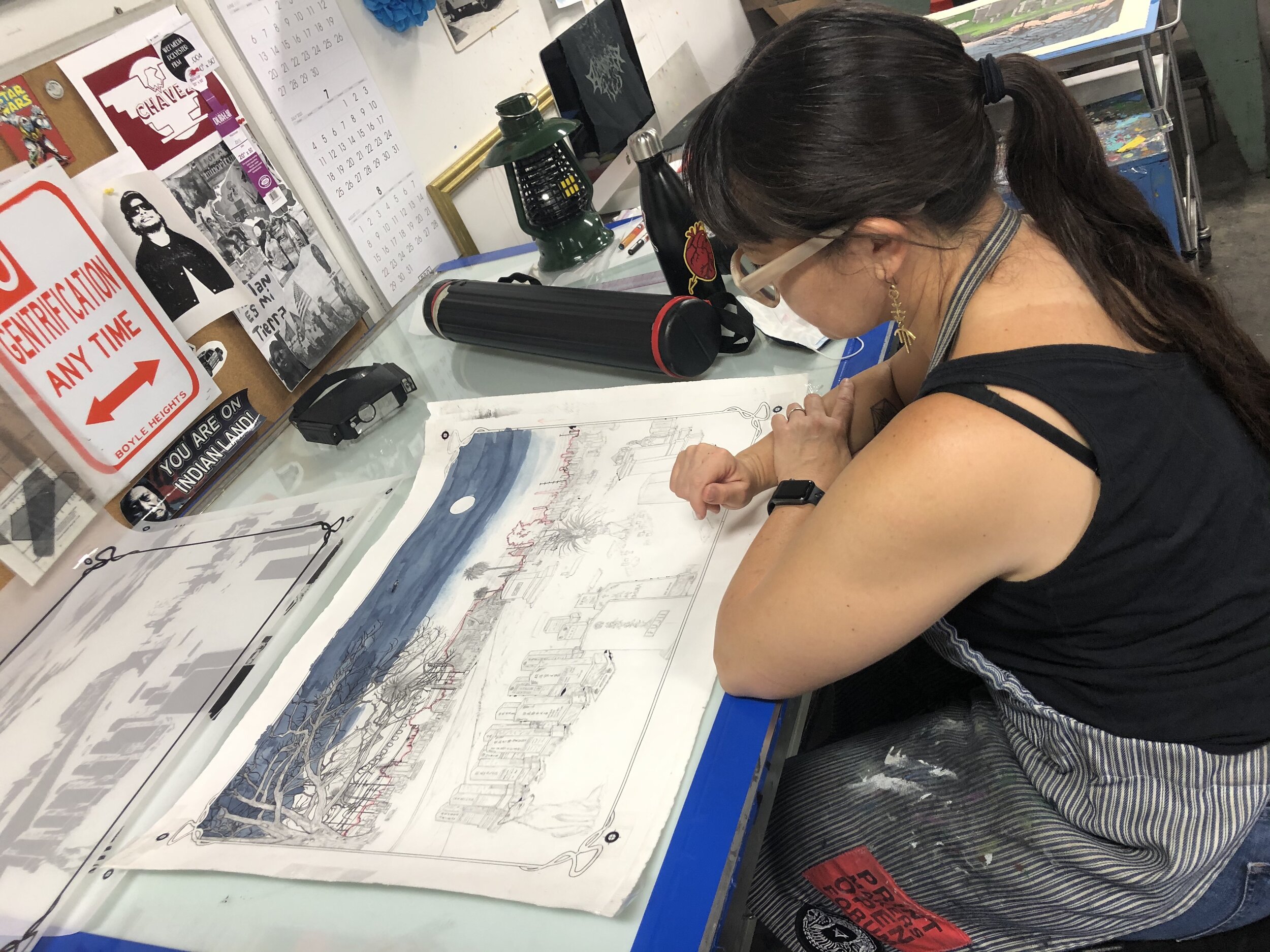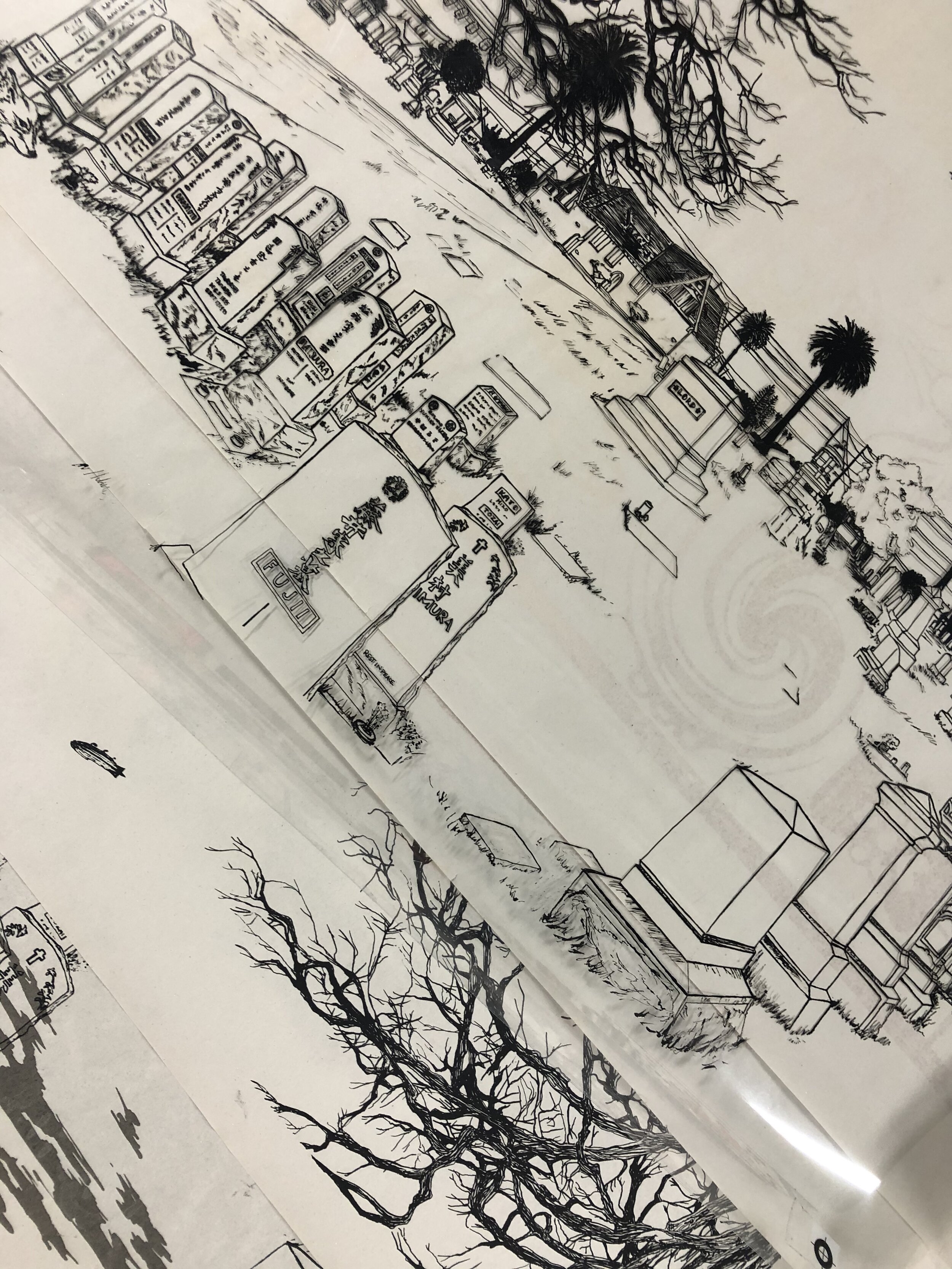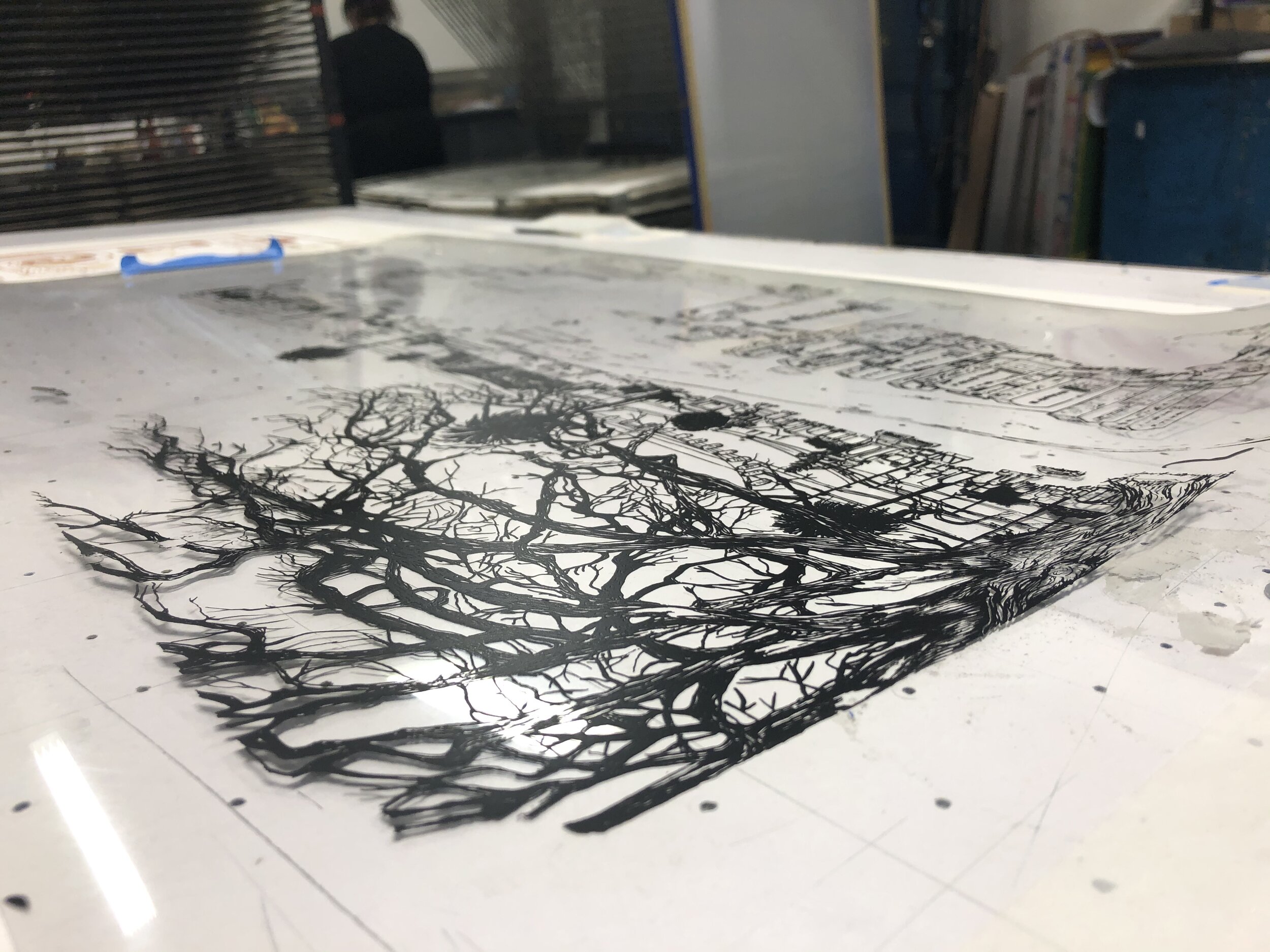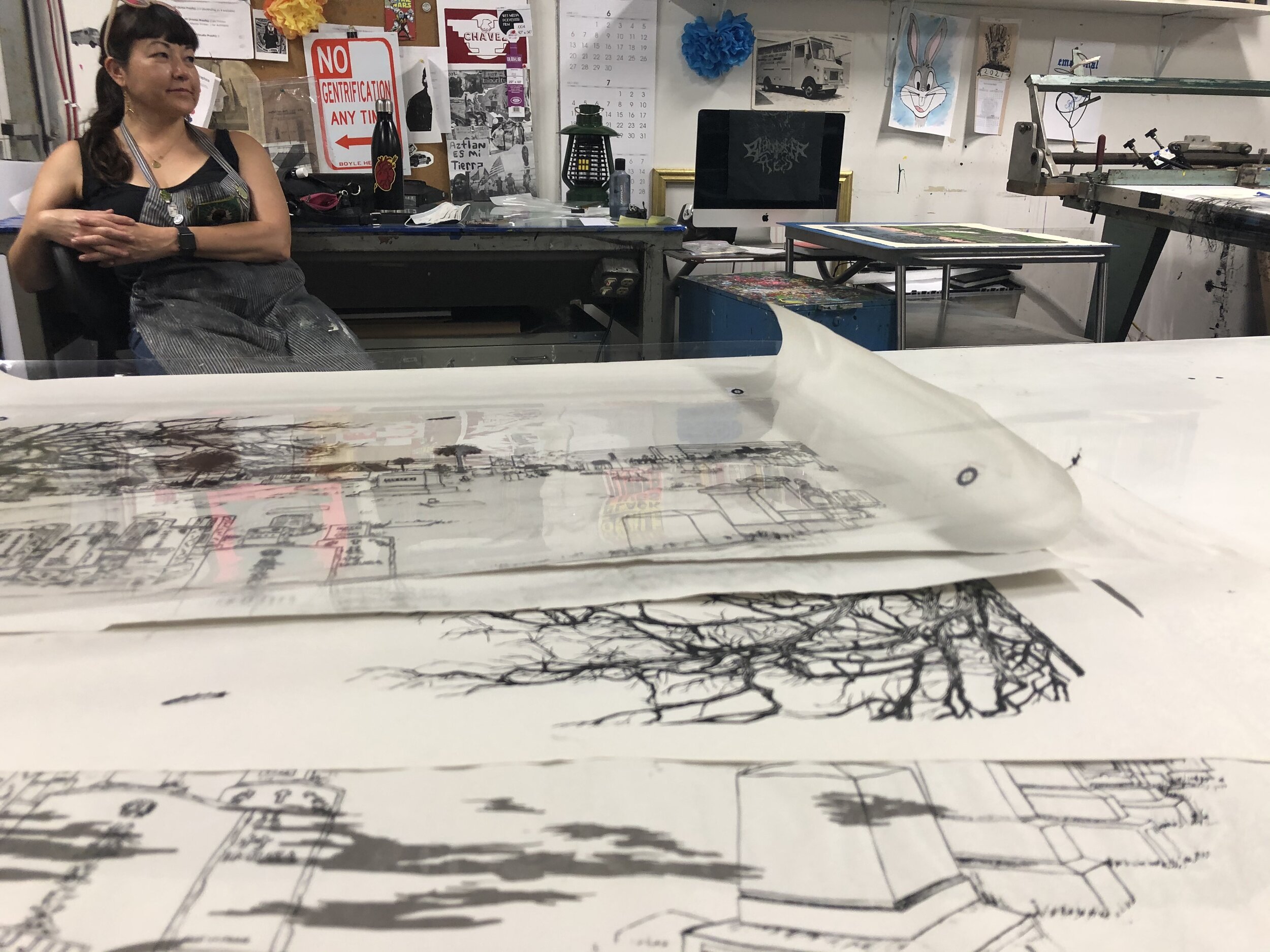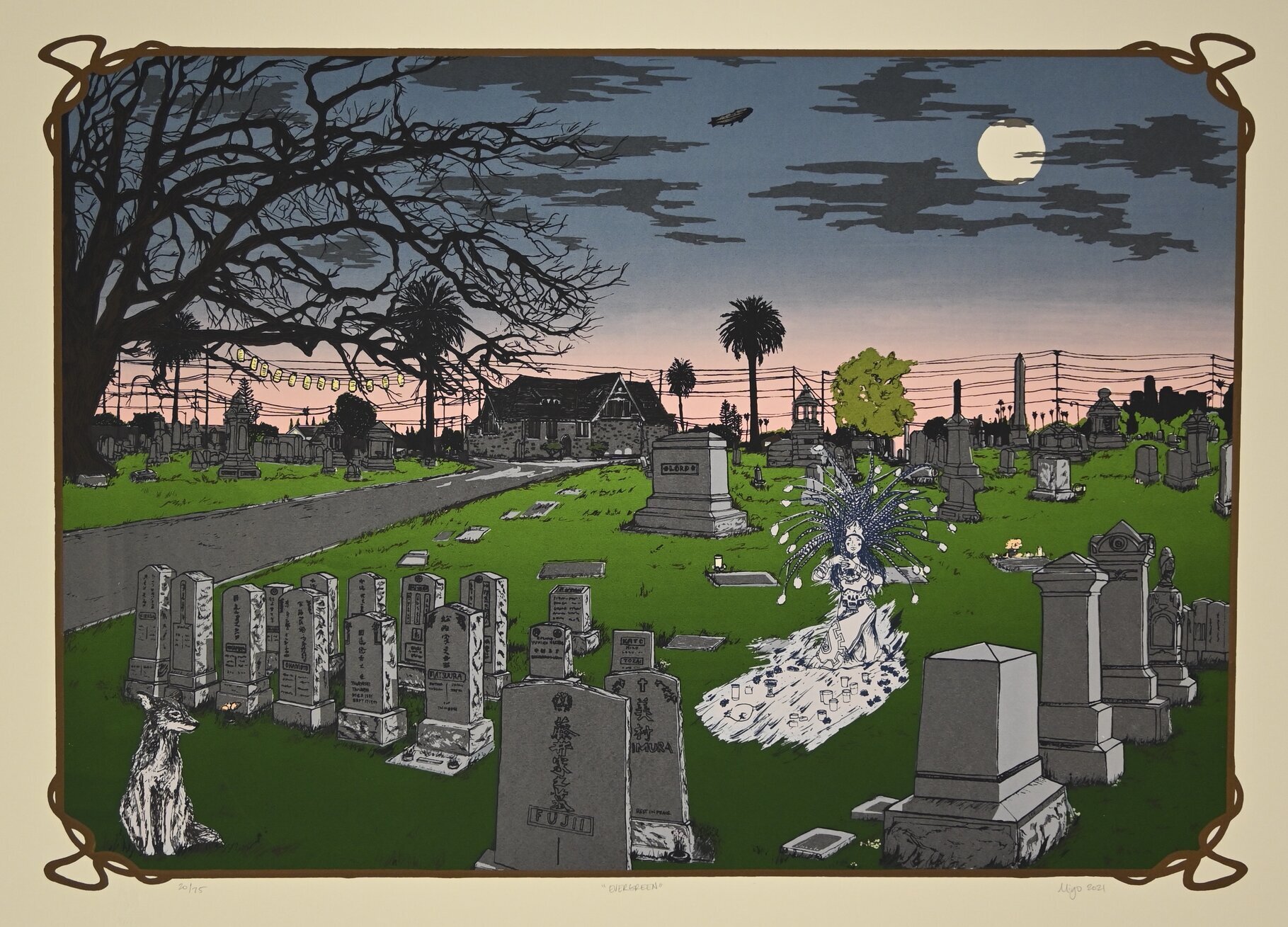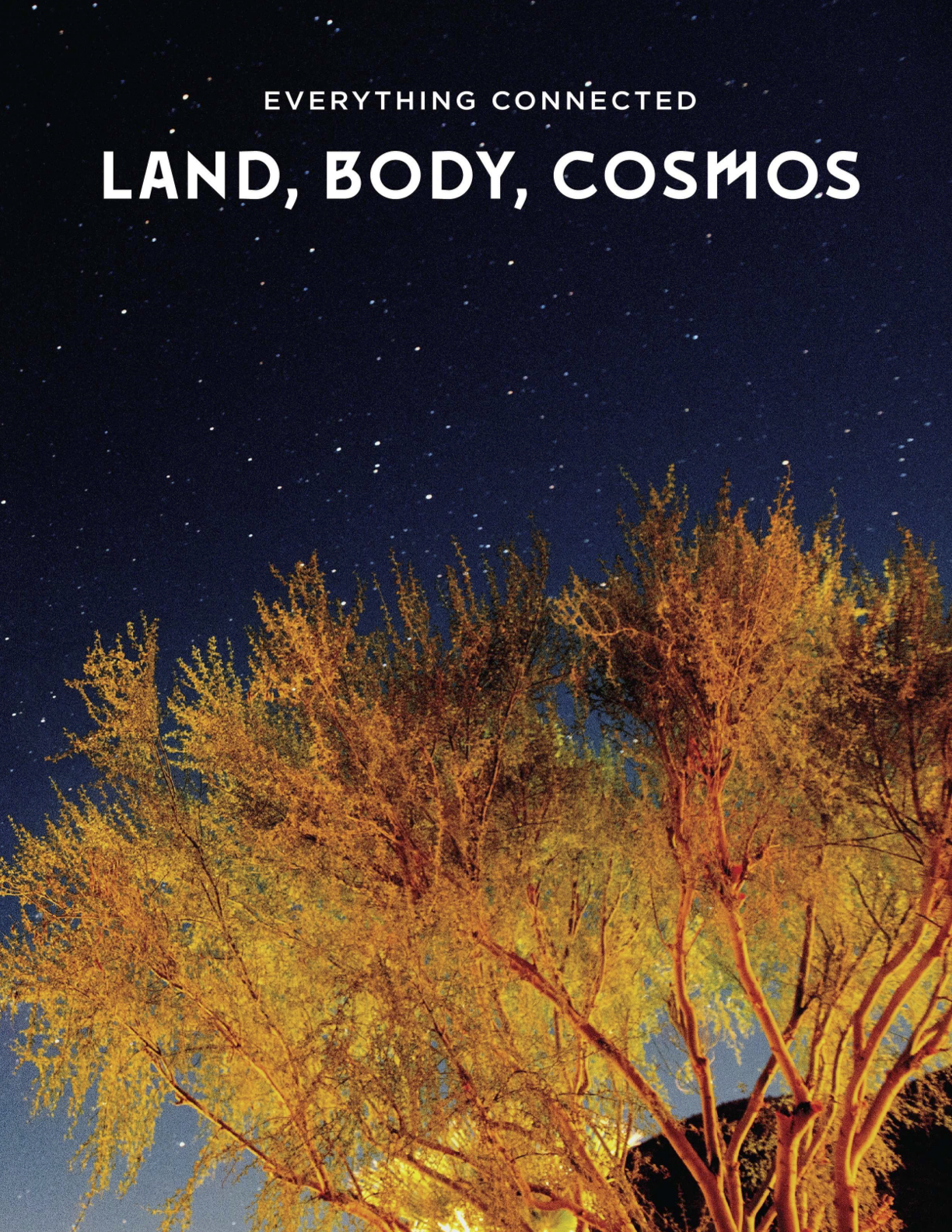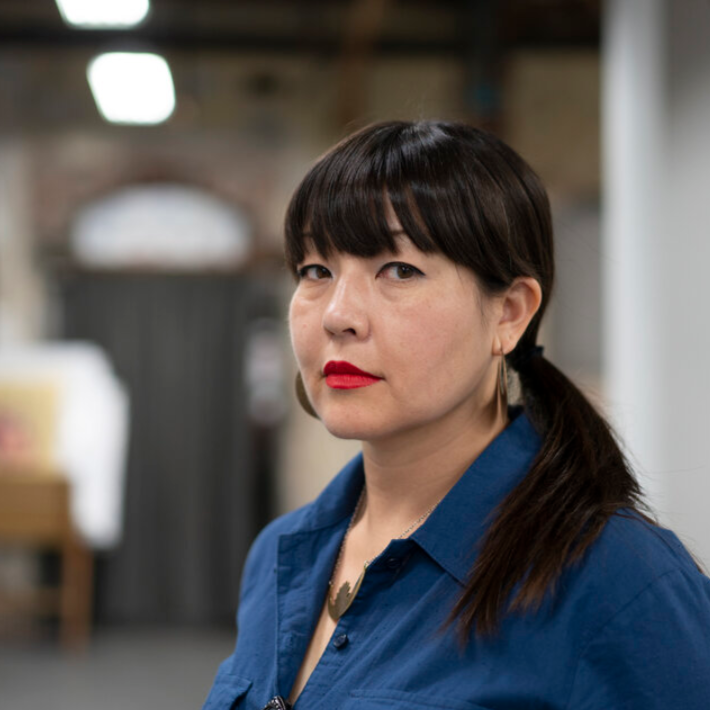Everything Connected: Land, Body, Cosmos Coalesces Visual and Performance Artists in Newest Exhibition at Self Help Graphics
By: Jennifer Cuevas, and Amanda Gomez
In the tradition of Self Help Graphics & Art, we are excited to open our doors to come together in community once again in honor one of our most beloved seasons of the year– Día de los Muertos!
Our Día de los Muertos season exhibition, Curated by Commemorative Print Artist, Miyo Stevens-Gandara, Everything Connected: Land, Body, Cosmos, will be on view from October 9 - November 24, 2021 in our gallery. We recently caught up with Miyo online for a conversation about the process of producing her latest print, Evergreen, 2021 for this 48th annual season, and her experience curating the Día de los Muertos exhibition.
Read our Q&A below with Miyo and check out the video on YouTube!
Q: Could you give us a brief introduction to the exhibit?
A: Yes. The title of the exhibition is Everything Connected: Land, Body, Cosmos and it's based on the idea that we're all connected in many different ways, profoundly, physically. We share the land. What we do impacts one another.
The artists I’ve chosen… I've chosen nine visual artists and nine sound artists, and I've had them either work in tandem or together to create works for the exhibition this year.
Q: Who are the artists you’ve invited for the exhibition?
A: The artists I've invited are nine visual artists and nine sound artists. Their names are, for the visual artists… We have Usen Gandara, Luis-Genaro Garcia, Sandra Low, Elyse Pignolet, Pável Acevedo, J. Leigh Garcia and myself (Miyo Stevens-Gandara), Ann Johnson and Carmen Argote. For the performing or sound artists, we have Joe Galarza, Harry Gamboa Jr, Beaux Mingus, Amy Shimshon-Santo, George Wheeler, Endy Trece, Sesshu Foster, Xochi Flores, and Ben Caldwell.
I found these artists… they were artists I've known or worked with or were recommended to me when I was telling people about my concept for the exhibition. It's always a little scary when you reach out to someone you don't know, but I was lucky enough every single one of the artists I asked said yes. And that shows a lot of trust in my vision for this project and I really appreciate that. We're very fortunate to have these artists.
Some are very, you know, established artists showing at MOCA and so, you know… we have one artist that's part of the LA Rebellion and Harry Gamboa Jr. is well known in our community. We're super lucky to have them…
Q: What can we look forward to at the exhibition?
A: Some of the works you'll see are a piece by Ben Caldwell, who is an elder in the Leimert Park community. He’s showing an older film he has… from his LA rebellion days, which is a movement of Black filmmakers in LA who came out of UCLA; and I hope people kind of get inspired to look up Caldwell's name. Elyse Pignolet- I don't believe she's shown at Self Help Graphics before, but she's a known artist in Los Angeles working in ceramic tile. Joe Galarza did a sound piece for us. He's a known sound artist in our community and visual artist; he did an amazing piece under Genetic Windsongs. And then we have Sesshu Foster who wrote a piece for this exhibition and… it's beautiful and he reads it. So those are some of the examples of what you'll experience.
Q: Tell us about your commemorative print.
A: The print has… I think it's nine layers, a lot of layers. The concept of the print– the images, Evergreen cemetery, this is a cemetery located in Boyle Heights [that] much of the audience will be familiar with.
This cemetery is significant to me personally because I have an aunt buried there in the Japanese section of the cemetery. It's also really significant to Self Help Graphics because it is the location for a lot of the early celebrations for Día de Los Muertos, and I wanted to kind of touch on those connections. It's significant to the area of Boyle Heights as an ever-changing neighborhood. It's the largest non-denominational cemetery in Los Angeles, and one of the oldest, so I thought it was a nice way to represent all these ideas that I've been thinking about in an image, in a location.
Q: What is the inspiration behind the piece? Any personal touches you really want to point out?
A: Like I mentioned, Evergreen cemetery is a symbolic cemetery for a lot of reasons. It includes and represents the cultural diversity of Los Angeles and I think that's super interesting and relevant. I worked really hard with the Master Printer, Dewey Tafoya, who is amazing, and Gabby, his assistant, to get a color palette that's similar to a colored palette that you find in Japanese woodcuts. Japanese woodcut’s interesting to me obviously, cause I'm part Japanese; but, early on when I was in my early days as an artist, I was kind of turned off by Japanese prints because I had seen so much of it growing up and then as I matured and became older and did more printmaking, I realized the mastery of that type of printmaking, and I love it.
So I really wanted to achieve a color palette of those prints. The Japanese prints are watercolor. Um, and so it's really hard to create a silk screen that is inherently different to match that color palette, but we were able to do that. And so you'll find that like subtle soft kind of color palette, that you see in those prints. I also have been looking at a lot of art deco imagery, um so looking at the kind of graphic nature of that and the edges of things in those art deco prints, and so I incorporated an art deco style border to the print.
Q: What do you want the public to take away from your print?
A: What do I want the public to take away from my piece? I felt a lot of responsibility with making this piece. First of all, I was super honored to be asked. Um, though I've been part of Self Help Graphics for a long time but...you know, I'm Japanese-American, so again, it's like a showing of trust in the artist to ask you to make a print.. That was a big deal to me and I wanted to make something that, you know, the community likes. So I want them to enjoy it. I want them to find something that they connect with being the theme of the exhibition and the idea behind the print. I want people to connect with it. And so I used a location that I felt like was really relatable to our community, really important to many different people in our community. Even people who have left our community have history in this area so that's part of what I hope they take away from it.
There is a spirit figure in the print that I haven't mentioned. That's kind of like the central part of it and... I got the idea for this, the spirit figure, this woman… she’s a spirit and so she… I got her from some of the archival pictures from the Self Help Graphics online photo archive. And so I modeled her after a couple of different dancers that I saw and I kind of did a composite image; and so she represents … she kinda is open to interpretation. People can see her literally as a spirit, people can see her as somebody that's like a goddess figure, representing nature, whatever it is, some kind of spiritual connection to that place. And so that's another thing that I hope people connect with and enjoy about this print.
Q: What does the Día de los Muertos season mean to you coming up as an artist, as well as a Los Angeles-based artist?
A: Día de los Muertos holds meaning to me at Self Help because I have been going to those celebrations since I was in high school, so that would have been in the late eighties, early nineties... and so it has a tradition for me as a community member. It's an important time to do things with reverence and thought and intention and I appreciate that. I'm not a religious person, I didn't grow up in a religious family. In my family though, you know, we thought about different Japanese traditions or there is something that wasn't huge in my family, but it is an important holiday or an important time, which is Obon, so this is a similar kind of celebration where your ancestors come back and visit you. And so I think what I like is that it sounds like these two ideas, these two cultures intersect as do many cultures in many ways, right? We can look through and find different ways that we have similarities. And I think that's the point of, you know, being in Los Angeles and being part of this community.
So for Obon, you know, you might put out some martinis, my grandparents loved martinis and... put out things and, and there's also little, characters. You put out little zucchini and eggplant, or, you know, different characters that are symbolic during that time and Día de los Muertos has its own kind of symbolic things. So yeah, it's meaningful to me in many ways, most of all, in which we can all kind of have a moment where we think and remember our ancestors and our people, and that's really a great thing to do together.
Q: How does this piece reflect your connection with the community and Self Help Graphics & Art?
A: This exhibition kind of shows a connection because... first of all, during the curating process… I think curating is a lot of work and it's, and you kind of, it's almost like its own art piece, right? And so the curatorial part of this that I enjoy is bringing people together. I've done a few projects like that with Self Help Graphics and what I love about it is that it's a chance for me to bring together my family, my art family at Self Help and bring them around a project or concept idea, and people connect. With this one in particular, it was super fun because I got to connect people who don't know each other, or maybe never worked together usually, or knew of each other, but only a little bit, so that's interesting because I'm also connecting people that work in a different process, right? I'm connecting poets and writers and musicians and sound artists, filmmakers, with other types of visual artists. And also I'm deliberately bringing in different communities of Los Angeles within the curatorial aspect of this project to, you know, grow connections because we're strong together and the more that we can use the rich resources of each other, you know, we can do a lot of great stuff. So that was the fun part, and then, of course, once that's done, we're bringing in the community to see it, which is super great. And so during this reception, on October 9th, we're gonna see all different kinds of people and their people come together and meet each other and intersect and connect- and that will be great.
Q: How has your expertise as a photographer influenced the design of the print?
A: So how did my photography background influence the design and concept of the print? I love this question because it has a lot to do with it. I'm a visual artist, I'm a printmaker, but my day job, I teach photography. I’m a photography professor. And so with all my work, it kind of always starts with the photograph. The landscape itself- I did mention that the piece was a composite of some of the things that I pulled from the photo archives of Self Help Graphics. I kind of just looked at different people and drew different things and kind of like took the hair from one thing or the gesture from another or the expression... and then the graveyard of the Evergreen cemetery itself is a composite drawing. So I went out to Evergreen and I took a whole bunch of different photos from different angles, trying to think about the direction I'm looking at; and so actually the image of the cemetery in my print isn't a real angle. It's a composite of different angles where I get artistic license. I mean, it's, you know, legitimately taken from Evergreen cemetery, but this gravestone may not have been there and this one might be over there and this scene exists, but maybe not, you know, all in the same angle so that was a composite also. And I just, like, I think when it boils down to photography influencing my artwork, I love detail. I just love to zoom in and see all the details, all the Kanji on the headstones that I can't read and all the... just the little details. So that's where it comes from. That influence helps bring in all the detail and I like to be able to take my own photographs too, and add that into the design of the print.
Q: What is your oldest memory of Self Help Graphics and Art?
A: My oldest memory of Self Help Graphics... is probably going to one of the Día de Los Muertos exhibitions. And in those days it was at the old building and I think one of the things that stand out in my mind is first seeing the mosaic in front of the building, which was super beautiful and a parking lot full of people and the Virgin statue, you know, food and all kinds of cool stuff at night. That's probably one of my earliest earliest memories. I know I did see bands there at different times and that, those exhibitions for Día de los Muertos were just everybody could bring something if I remember correctly and so I thought that was really cool too. It wasn't this kind of hold you at an arm's length art exhibition. It was, everybody was involved, and that was really impressive.
I've told this story many times before, but I got interested in Self Help because I went to Schurr High School in Montebello and we had a substitute teacher named Arturo Urisa, who's still around still; he was a sub for our art class and he taught us how to hide curse words in our artwork and he showed us his artwork, and I just thought that was really cool, you know? So some of my friends decided to go and check it out, but yeah... I was kind of living in the Montebello area at the time and so it wasn't, you know, that far, and we are familiar with kind of that general area. So it was really fun.
Q: When can people see at the Día de los Muertos exhibition?
A: I want to invite everyone out there watching to come and see the exhibition. We have a reception on October 9th from 6:00 to 9:00 PM. We’d love to have you guys come and check it out. Bring your headphones because you'll get an even more immersive experience that way. There are different QR codes where you can put your smart phone over and you'll hear the sound paired with each piece. And if you can't make the reception, please come later in the year anyway. The exhibition is open from October 9th to November 24th, right before Thanksgiving, so there's plenty of time to come check it out. I know you'll really enjoy it. it's a great show.
Learn more about this exhibition at www.selfhelpgraphics.com/exhibitions and www.selfhelpgraphics.com/diadelosmuertos. In addition to the visual and sound artworks, a small self-published exhibition catalogue, designed by Usen Gandara, is available on our online shop while supplies last here.
Jennifer Cuevas is SHG’s Communications Consultant. She is a Cultural Arts Producer, with a passion for the arts, social justice and policy. Amanda Gómez is a student at Pitzer College and Self Help Graphics & Art’s Día de los Muertos Los Angeles County Arts Intern.

